Sensor Sweep: Arkham House, D&D, Ray Bradbury, Horror Comic Books
Monday , 4, November 2024 Sensor Sweep 1 CommentPublishing (Don Herron): Ready to order, the book on the Classic Era of Arkham House Ephemera I’ve been promising for years awaits you. 150 Items covered (with 3 playfully hidden away for the readers who like to have a little fun with their ephemera). The back cover blurbage sums it up, I think — you’ll see that sales pitch on the Amazon page. Meanwhile, until they get the Look Inside feature activated, here’s the front page blurbage:
Arkham House Ephemera I’ve been promising for years awaits you. 150 Items covered (with 3 playfully hidden away for the readers who like to have a little fun with their ephemera). The back cover blurbage sums it up, I think — you’ll see that sales pitch on the Amazon page. Meanwhile, until they get the Look Inside feature activated, here’s the front page blurbage:
Fiction (Adventures Fantastic): If you have never read, or heard of A. Merritt’s The Ship of Ishtar, then you are in luck. On the centennial anniversary of its first publication, November 8, a new, definitive printing of it by DMR books will be available to buy in paperback or digital form (Centennial Edition of A. Merritt’s Ship of Ishtar Coming in November — DMR Books ).
Radio (Comics Radio): Despite the half-hour run time, this episode gives us an effective and atmospheric adaptation of H. Rider Haggard’s classic novel.
Robert E. Howard (Roy Reads Anything): Robert E Howard in Orbit | 70s Brit paperbacks.
D&D (Dungeons & Dragons Fan): 2024 has been a banner year for Dungeons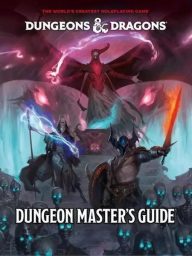 & Dragons, with Wizards of the Coast ushering in the 50th anniversary of the game in addition to launching a new Player’s Handbook that offers some signification rules to DnD 5e. In more recent news, Wizards of the Coast held their D&D Direct 2024 event and announced a slew of upcoming titles.
& Dragons, with Wizards of the Coast ushering in the 50th anniversary of the game in addition to launching a new Player’s Handbook that offers some signification rules to DnD 5e. In more recent news, Wizards of the Coast held their D&D Direct 2024 event and announced a slew of upcoming titles.
Games (Kairos): For many gamers who grew up with the classics of the 1980s and 1990s, 8 and 16-bit video games hold a special nostalgic charm.
Yet despite the recent surge in retro style indie games, it’s apparent that even talented Millennial developers struggle to recreate the authentic look and feel of original titles from the 2D era.
Writers (Fandom Pulse): It appears the corporate-government complex will go absurd lengths to get people into situations where they will be silenced, and former Baen Books science fiction author Sarah Hoyt speculated she was victim of a honeypot scheme on January 6, 2021.
Games (Valliant Renegade): WOKE Ubisoft Lost $9 Billion & FAILED Management Wants to Buy it Out | Ubisoft Stock | Tencent | Gaming News | Entertainment News | Stock Market News | Disney Star Wars FAIL
Comic Books (Tentaclii): Yes, I remember that well. Many small shops in the West Midlands of England had a spinner-rack of usually fairly random-but-recent American monthly imports, often visible from the window and priced for the British in pennies rather than U.S. cents. Sometimes they had a big job-lot of ship-ballast comics (cent-priced, U.S. news-stand returns?)… and then there were huge piles of American dynamite to sort through.
Bradbury (Imaginative Conservative): mong Ray Bradbury’s many valuable science fiction and fantasy works are some designed specifically for younger readers. One of these is the delightful and strangely neglected The Halloween Tree (1972), which by rights should be as much a part of this season as spiced cider and jack-o’-lanterns.
Tolkien (Notion Club Papers): The Notion Club, as depicted by Tolkien, is a magical society; albeit not of the earlier and formal kind (of which Charles Williams was an active and advanced participant) that was characterized by graded initiations, sworn secrecy, and costumed and scripted rituals.
Science Fiction (M Porcius): Over the last five blog posts we’ve been reading from paperback anthologies I own. Well, now we are six. On the anthologies shelf of the MPorcius Library we find a copy of World’s Best Science Fiction: Fourth Series, a 1970 reprint of World’s Best Science Fiction: 1968 edited by Donald A. Wollheim and Terry Carr.
reading from paperback anthologies I own. Well, now we are six. On the anthologies shelf of the MPorcius Library we find a copy of World’s Best Science Fiction: Fourth Series, a 1970 reprint of World’s Best Science Fiction: 1968 edited by Donald A. Wollheim and Terry Carr.
 Fiction (With Both Hands): The Wizard of Oz by L. Frank Baum is a book so famous it is almost forgotten. That sounds like it should be impossible, but what I mean is that the story’s very popularity has ensured that the plot and characters are enshrined in popular culture while hardly anyone reads the book itself.
Fiction (With Both Hands): The Wizard of Oz by L. Frank Baum is a book so famous it is almost forgotten. That sounds like it should be impossible, but what I mean is that the story’s very popularity has ensured that the plot and characters are enshrined in popular culture while hardly anyone reads the book itself.
Fiction (Wormwoodiana): Cold Harbour begins with an urbane ‘Prelude’ set far away from England, on Capri, and narrated by the nameless host, a former doctor and now expatriate author, entertaining his guests. Sitting out on the moonlit terrace after dinner is Ronald Wake, an old friend who still practiced medicine, and his wife Evelyn. Making up the foursome is Harley, the island’s new Anglican chaplain.
Fiction (Jon Black Writes): Reaching its apogee in the final two decades of the 19th century, Decadence is an artistic movement and, to a lesser extent, a school of thought placing an individual’s aesthetic experience as the highest good, perhaps the only real good. While, in theory, that could code for any number of things, in reality there were a number of attitudes and interests shared by most Decadents. Those shared, consistent features are what we mean when we say “The Decadent Movement.”
Publishing (Spectator): It was both a courtesy and the right thing to do to seek permission to quote their work. And the process was mostly rather heartening. Not much more than £100 secured me the right to quote the stanza of W.H. Auden’s wonderful ‘September 1st, 1939’ from which my book takes its title as the epigraph.
Art (John Coulthart): Ballantine Books published a number of Lovecraft and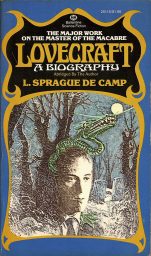 Lovecraft-related titles in paperback in 1976, all with uniform cover designs featuring a bold Art Nouveau-style border. I’ve seen these covers on many occasions but hadn’t paid the artwork much attention
Lovecraft-related titles in paperback in 1976, all with uniform cover designs featuring a bold Art Nouveau-style border. I’ve seen these covers on many occasions but hadn’t paid the artwork much attention
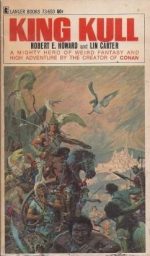 Fantasy (Sprague de Camp Fan): Lancer Books published King Kull in 1967. The stories that Lin edited and completed were: “Black Abyss,” “Riders Beyond the Sunrise,” “Wizard and Warrior.” “The Striking of the Gong” had been completed by Robert E. Howard but was edited for publication by Lin Carter. The other stories were edited by Glenn Lord. And there were edits a plenty. I’ve detailed the edits to each story in previous posts.
Fantasy (Sprague de Camp Fan): Lancer Books published King Kull in 1967. The stories that Lin edited and completed were: “Black Abyss,” “Riders Beyond the Sunrise,” “Wizard and Warrior.” “The Striking of the Gong” had been completed by Robert E. Howard but was edited for publication by Lin Carter. The other stories were edited by Glenn Lord. And there were edits a plenty. I’ve detailed the edits to each story in previous posts.
H. P. Lovecraft (R’lyeh Reviews): The Dunwich Horror is one of horror author H.P. Lovecraft’s most famous stories. It takes place in the mouldering decrepit parts of Massachusetts where the ravines seem to run deep and the trees appear to leap up to ring the stone-topped hills from strange sounds emanate, and few if any of the villagers appear to work their boulder strewn pastures.
Fiction (Rough Edges): THE CASE OF THE LAME CANARY is the 11th novel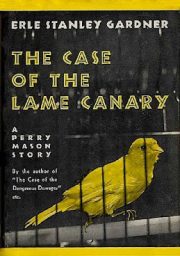 in the Perry Mason series, published in hardcover by William Morrow in 1937 and reprinted many times in paperback since then. It starts off, as so many of the novels do, with something odd catching Perry Mason’s interest. A beautiful young woman carrying a canary in a cage visits Mason’s office and tries to hire him to represent her sister in a divorce action.
in the Perry Mason series, published in hardcover by William Morrow in 1937 and reprinted many times in paperback since then. It starts off, as so many of the novels do, with something odd catching Perry Mason’s interest. A beautiful young woman carrying a canary in a cage visits Mason’s office and tries to hire him to represent her sister in a divorce action.
Fiction (Jordan M Poss): I could probably come up with a longer list, but these immediately suggest themselves. Again, all of the above are superficial general parallels and there are plenty of exceptions—about which more below—but if you were to construct either a gothic or alien story, it would probably have most or all of those traits. But there are deeper and more important qualities that both have in common: Their intrusive quality, the way the uncanny or extraterrestrial is perceived as breaking in upon normal life from somewhere else
Horror (DMR Books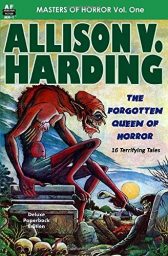 ): There are also writers who aren’t well known that I believe deserve more respect. Harold Lamb’s great adventure stories were close to being forgotten if not for Howard Andrew Jones. Another such case is that of Weird Tales writer Allison V. Harding.
): There are also writers who aren’t well known that I believe deserve more respect. Harold Lamb’s great adventure stories were close to being forgotten if not for Howard Andrew Jones. Another such case is that of Weird Tales writer Allison V. Harding.
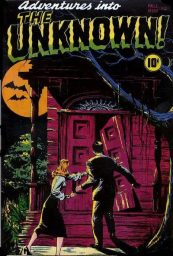 Comic Books (Dark Worlds Quarterly): Comic books used the haunted house too. The very first true Horror comic was Adventures Into the Unknown #1, Fall 1948. It featured a haunted house on the cover and has a story about such a building. (It also did an adaptation of The Castle of Otranto, all courtesy of Pulp writer, Frank Belknap Long.) This comic set the standard form for all the EC comics that are beloved by comic fans later.
Comic Books (Dark Worlds Quarterly): Comic books used the haunted house too. The very first true Horror comic was Adventures Into the Unknown #1, Fall 1948. It featured a haunted house on the cover and has a story about such a building. (It also did an adaptation of The Castle of Otranto, all courtesy of Pulp writer, Frank Belknap Long.) This comic set the standard form for all the EC comics that are beloved by comic fans later.
Games (MSN): Welsh culture and history inspire video games like Maid of Sker and Assassin’s Creed: Black Flag, featuring Welsh protagonists and settings. Games like Koudelka and Ni no Kuni incorporate Welsh lore, dialects, and locations, adding a unique touch to the gaming experience.
Radio (Archive.org): This upload contains 7i episodes of the Old Time Radio show, The Mysterious Traveler. The show, airing on the Mutual Network from 1943-1952, focused on mysteries, both natural and supernatural. Despite the long run, only these episodes appear to have survived.
James Bond (Zev Stellar): James Bond Producer Albert R. “Cubby” Broccoli banned the release of these commentaries! In 1991 Criterion Collection released the first 3 James Bond movies on LaserDisc with special commentary by various crew members. Some of the things said on these would not definitely not go well nowadays!
Comic Books (Dark Worlds Quarterly): Solomon Kane, unlike Conan, Kull or Red Sonja, never had a long-running Marvel series that required different writers to try their hand at Robert E. Howard’s game. Most of the Solomon Kane comics are adaptations, some based on whole stories, others taken from fragments. The comics here are not those. For those, go here. These three comics are the work of Donald F. Glut.
History (English Heritage): New research reveals previously undiscovered ‘witches marks’ at Gainsborough Old Hall.
Horror (Paperback Warrior): Dracula, written by an Irishman named Bram Stoker, was published in 1897. It was later a huge success in the 20th century and is the most popular horror novel of all-time. It inspired countless media platforms including movies, television shows, animated cartoons, action figures, comics, breakfast cereals, and costumes.
History (Metatron): I REFUSE To Use BCE/CE And Here is Why.
Fantasy (Library Ladder): This is the fifth installment in my series of videos exploring Michael Moorcock’s Eternal Champion saga. Elric of Melnibone, was a rebel on and off the page. An agent of Chaos in his own story, he flouted the standard tropes of the fantasy genre in our world when he first appeared in print more than 60 years ago. This is a brief overview of Elric’s literary origins, his existence as Moorcock’s alter-ego, and his impact on the genre. I also provide a suggested reading order.
Geology (Bayou Renaissance Man): It looks as if a South American volcano may have played a major role in worldwide climate and weather problems many centuries ago. The article’s over a decade old, but I’ve just come across it, and I thought other readers might be interested as well.
Excellent coverage of Horror Comics by Dark Worlds. Definitely a must-read if you don’t know the pre-Code Horror stuff.
The Tentaclii article is solid reminiscence, and recalls that without some distribution or marketing method similar in nature to Newsstand distribution, you are not going to grow your physical or digital audience. Going Direct Market killed the feeder chain of new comic book readers, especially the young ones.
As he notes, the comic book piracy sites are the best things for comic books marketing in that regard right now. Sad but true.